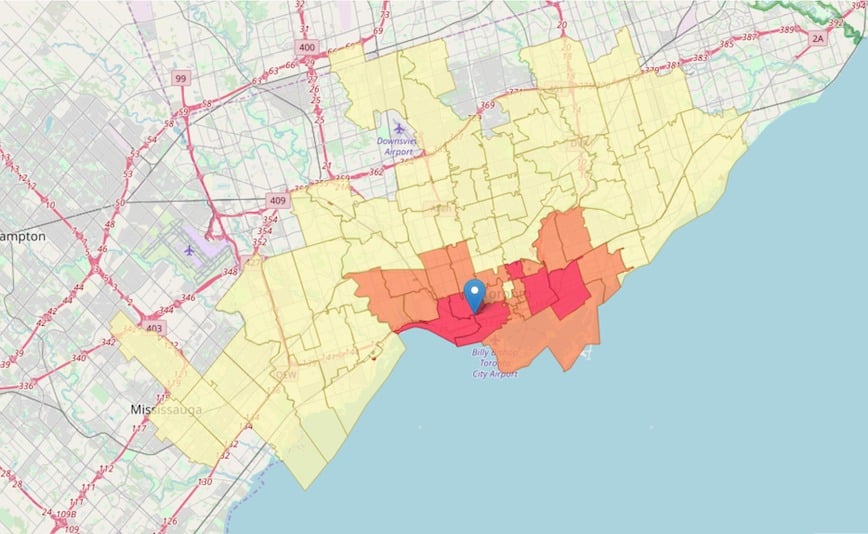Several different consumer profiles comprise a single store’s clientele. These groups of consumers have their own specific buying habits and expectations; efficiently attracting them into your store requires a distinct form of treatment. Here is how you can benefit from your five primary client groups.
Residents
Those who live in proximity to a business contribute to the very heart of its revenue. By analyzing a trade area, we quickly notice 50% of a company’s revenue comes from shoppers who reside in zones that access the epicenter — the store’s location —within minutes.
 Trade area of businesses on King Street West, a busy street in Toronto
Trade area of businesses on King Street West, a busy street in TorontoFrom the point of view of the consumer, a Hubspot study demonstrates 92% of city dwellers shop in stores located 15 minutes away or less from their homes. To convert these local clients, focus on ease. They appreciate home delivery, pedestrian drives, or click and collect for everyday purchases.
Passerby
Passerby clients are more occasional and have a stronger proclivity for turning to your direct competition. To expand your zone of influence, the best tool remains integration between brick and mortar and e-commerce. According to an analysis by Google Insights, “near me” shopping searches have increased 200% in the last two years. Many buyers, especially young shoppers, begin their shopping online then finish in-store. It is now a requirement to have your physical address up to date on different search engines and on your e-commerce website.
Workers
Workers form a regular clientele that generates stable revenue for your company. Regularity translates to retention and client experience. After a few return trips, these clients who are now familiar with your brand will continue to shop at your store for several months. Therefore, you should locate surrounding offices and promote sales to entice their employees to visit your store and make their first purchases. Once you’ve captured their attention, focus on maintaining your relationship by implementing personalized loyalty programs and asking clients about their expectations.
Tourists
Few shops have the opportunity to have the same notoriety as Louis Vuitton in the Champs-Élysées. For the vast majority of retailers, this reputation needs to be built. Certain retailers manage to transform their brand into a visual destination with the help of their Instagram account. These stores rouse emotion and incite tourists to seek them out, promoting their appealing aesthetic as a travel destination.
However, tourists typically shop according to recommendations from other users. As per a study by BrightLocal, 86% of online users read online comments and 40% make decisions accordingly. Tourists generally concentrate their purchases on a small number of stores. Make sure you are referenced in tour guides or travel websites.
Non-clients
Non-clients are distinguishable from occasional clients. Rather than rarely buying your products, they have either never stepped foot in your store or have chosen to abandon or avoid your brand altogether. To attract this clientele into your store, investigating their needs and understanding the origin of their dissatisfaction is imperative. Luckily, regaining customer trust has proven to be less expensive than acquiring new clients. If, on the contrary, your brand remains unknown to this target, consider improving marketing campaigns and, most importantly, focusing on the satisfaction of your current clients. Effectively, having satisfied customers remains the best way to obtain positive word-of-mouth and enhance notoriety.